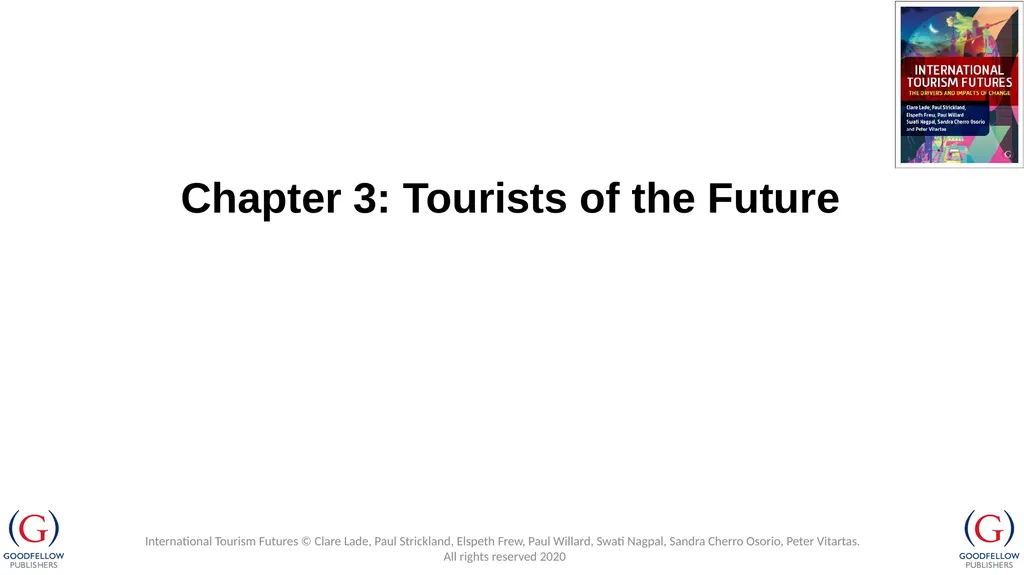Chapter 3: Tourists of the Future International
Author : luanne-stotts | Published Date : 2025-05-14
Description: Chapter 3 Tourists of the Future International Tourism Futures Clare Lade Paul Strickland Elspeth Frew Paul Willard Swati Nagpal Sandra Cherro Osorio Peter Vitartas All rights reserved 2020 Chapter Outline Introduction Smart
Presentation Embed Code
Download Presentation
Download
Presentation The PPT/PDF document
"Chapter 3: Tourists of the Future International" is the property of its rightful owner.
Permission is granted to download and print the materials on this website for personal, non-commercial use only,
and to display it on your personal computer provided you do not modify the materials and that you retain all
copyright notices contained in the materials. By downloading content from our website, you accept the terms of
this agreement.
Transcript:Chapter 3: Tourists of the Future International:
Chapter 3: Tourists of the Future International Tourism Futures © Clare Lade, Paul Strickland, Elspeth Frew, Paul Willard, Swati Nagpal, Sandra Cherro Osorio, Peter Vitartas. All rights reserved 2020 Chapter Outline Introduction Smart tourism Virtual tourism Smart boredom and its impact on the travel experience Super sabbaticals The solo traveller Summary Case study International Tourism Futures © Goodfellow Publishers 2020 Introduction Today, more and more people are travelling than ever before. 1.4 billion international tourist arrivals recorded in 2018 The forecasted 1.8 billion international arrivals set to be reached well before its predicted 2030 (UNWTO, 2019). Key drivers of change, along with several trends considered to have an impact on the future development of the international tourism industry. Future tourist behaviour trends identified. International Tourism Futures © Goodfellow Publishers 2020 Smart Tourism Smart tourism ‘involve (s) multiple components and layers of smartness supported by information and communication technologies (ICTs) inclusive of hardware, software, groupware, netware and humanware’ (p.180), as the synergies of these systems help: …facilitate operational and strategic management of organisations by enabling them to manage their information functions and processes as well as communicate interactively with their stakeholders for achieving their mission and objectives. (Neuhofer, Buhalis and Ladkin, 2014, p. 341). International Tourism Futures © Goodfellow Publishers 2020 Smart Tourism…cont. Smart tourism refers to ‘smart’ destinations ‘that apply smart principles to urban or rural areas with consideration for both residents and tourists in their efforts to support mobility, resource availability and allocation, sustainability and quality of life/visits’ (Gretzel et al., 2015, p. 180). International Tourism Futures © Goodfellow Publishers 2020 Smart Tourism… cont. In addition to the destination component, there is the ‘smart’ experience component which Gretzel et al. (2015) defines as one that: ‘specifically focuses on technology-mediated tourism experiences and their enhancement through personalisation, context-awareness and real time monitoring’ (p. 181). International Tourism Futures © Goodfellow Publishers 2020 Smart Tourism…cont. Smart business refers to ‘the complex networks that creates and supports the exchange of touristic resources and the co-creation of the tourism experience’ (Gretzel et al., 2015, p. 181). Smart tourism spans three layers across these key components. Firstly, the “smart information layer that aims at collecting data; a smart exchange layer that supports interconnectivity; and, a smart processing layer that is responsible for the analysis, visualisation and intelligent use of data” (p. 181). International Tourism Futures © Goodfellow Publishers 2020 Smart Tourism…cont. In considering these important














